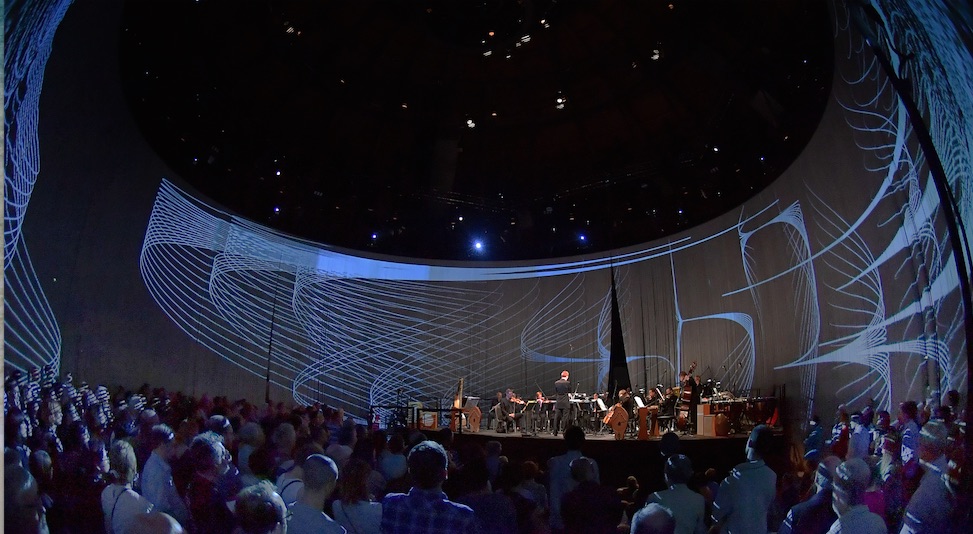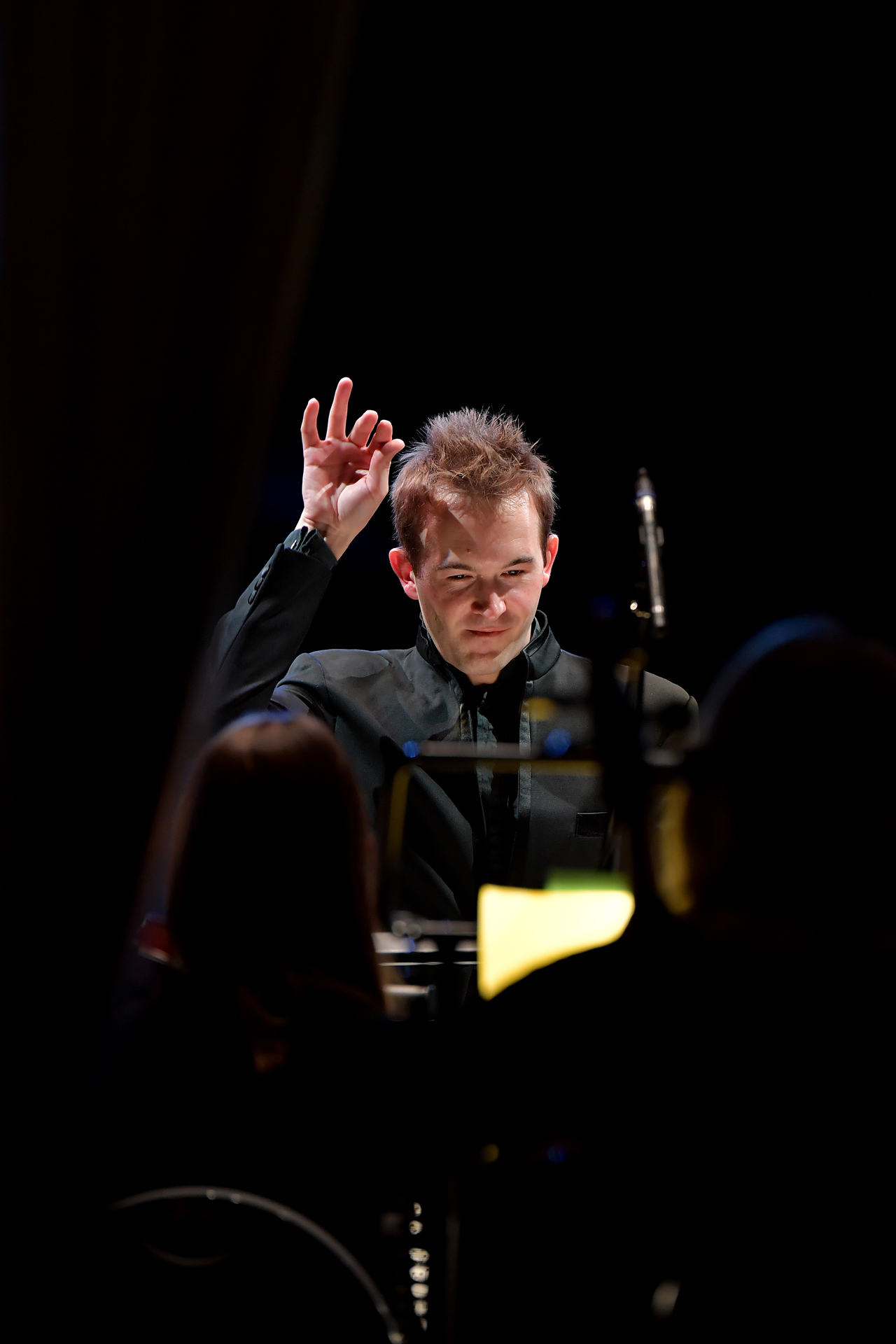Proms at Roundhouse: London Sinfonietta, Gourlay | reviews, news & interviews
Proms at...Roundhouse: London Sinfonietta, Gourlay
Proms at...Roundhouse: London Sinfonietta, Gourlay
An enchanted fusion of microtonal magic and luminous projection
Some enchanted afternoon in Camden Town… the Proms returned to the Roundhouse after four decades with a dreamlike fusion of sound, space and light. Ron Arad’s Curtain Call – a 360° installation of 5,600 sillicon rods – encircled the London Sinfonietta and audience in its luminescent embrace, a haze of microtonal music slinking through a sequence of glimmering projections.
The programme built towards György Ligeti’s Ramifications, an indelible masterpiece of the gauziest microtonal weave, and part-inspiration for Georg Friedrich Haas’s Open Spaces II (2007). In this ravishing work Haas also pays homage to composer James Tenney, bright clouds of partials skittering off two sets of cymbals and gongs, recalling Tenney’s own gong tour de force, Having never written a note for percussion. Seething light projections chimed with the metallic percussion, just as fractal-like threads picked up the wandering line of spindly strings (pictured below). Where the writhing spaghetti belonged is harder to say.

There’s an indefinable, almost tragic, grandeur to Haas’s music. Through subtly dissonant meshes, performed by two string groups in and outside the curtain playing a sixth of a tone apart, he channels a deep vein of Viennese Romanticism. Overtones of the bass’s sub-bass note generated surprisingly warm consonance, and only half-way through did I become completely aware of the friction between the two string groups, one slightly out of focus, as if at a distance. London Sinfonietta’s seasoned players realised this demanding score with exquisite skill, right up to the precise but manic trilling of its end.
Besides this, works of the younger generation felt like junior exercises in developing a single strand of Ligeti’s thinking. Mica Levi’s new piece Signal before War (2016) enacted the slow, continuous ascent of pitch up the violin from bottom to top over a three minute span. Jonathan Morton rendered it with mesmerising control, breaking the tension in a flourish of vibrato. Jonny Greenwood’s Smear (2004) plays with the lithe glissandi of two ondes martenots, which slither snake-like through a shifting orchestral texture. It’s an appealing dreamscape, in no way enhanced by images of autumn trees.

And then came the Ligeti, smelling, as he memorably said, "high, the music is starting to decompose". Here, the tuning of one string group is a quarter-tone lower than the other, creating a quivering web of 24 pitches, moving through extremes of dynamic, pulsing with interference. This was a performance of extraordinary subtlety and precision. Visuals, by SDNA Ltd, had been effective when abstract; here we had the ludicrous introduction of giant spiders. Ligeti's crawling disintegration needs no arachnid assistance.
rating
Share this article
Add comment
The future of Arts Journalism
You can stop theartsdesk.com closing!
We urgently need financing to survive. Our fundraising drive has thus far raised £49,000 but we need to reach £100,000 or we will be forced to close. Please contribute here: https://gofund.me/c3f6033d
And if you can forward this information to anyone who might assist, we’d be grateful.

Subscribe to theartsdesk.com
Thank you for continuing to read our work on theartsdesk.com. For unlimited access to every article in its entirety, including our archive of more than 15,000 pieces, we're asking for £5 per month or £40 per year. We feel it's a very good deal, and hope you do too.
To take a subscription now simply click here.
And if you're looking for that extra gift for a friend or family member, why not treat them to a theartsdesk.com gift subscription?
more Classical music
 Weilerstein, NYO2, Payare / Dueñas, Malofeev, Edinburgh International Festival 2025 review - youthful energy and emotional intensity
Big-boned Prokofiev and Shostakovich, cacophonous López, plus intense violin/piano duo
Weilerstein, NYO2, Payare / Dueñas, Malofeev, Edinburgh International Festival 2025 review - youthful energy and emotional intensity
Big-boned Prokofiev and Shostakovich, cacophonous López, plus intense violin/piano duo
 theartsdesk at the Three Choirs Festival - Passion in the Cathedral
Cantatas new and old, slate quarries to Calvary
theartsdesk at the Three Choirs Festival - Passion in the Cathedral
Cantatas new and old, slate quarries to Calvary
 BBC Proms: Estonian Philharmonic Chamber Choir, Kaljuste review - Arvo Pärt 90th birthday tribute
Stillness and contemplation characterise this well sung late-nighter
BBC Proms: Estonian Philharmonic Chamber Choir, Kaljuste review - Arvo Pärt 90th birthday tribute
Stillness and contemplation characterise this well sung late-nighter
 BBC Proms: Kholodenko, BBCNOW, Otaka review - exhilarating Lutosławski, underwhelming Rachmaninov
Polish composers to the fore in veteran conductor’s farewell
BBC Proms: Kholodenko, BBCNOW, Otaka review - exhilarating Lutosławski, underwhelming Rachmaninov
Polish composers to the fore in veteran conductor’s farewell
 theartsdesk at the Pärnu Music Festival 2025 - Arvo Pärt at 90 flanked by lightness and warmth
Paavo Järvi’s Estonian Festival Orchestra still casts its familiar spell
theartsdesk at the Pärnu Music Festival 2025 - Arvo Pärt at 90 flanked by lightness and warmth
Paavo Järvi’s Estonian Festival Orchestra still casts its familiar spell
 BBC Proms: Batsashvili, BBC Scottish Symphony Orchestra, Ryan Wigglesworth review - grief and glory
Subdued Mozart yields to blazing Bruckner
BBC Proms: Batsashvili, BBC Scottish Symphony Orchestra, Ryan Wigglesworth review - grief and glory
Subdued Mozart yields to blazing Bruckner
 Classical CDs: Hens, Hamburg and handmaids
An unsung French conductor boxed up, plus Argentinian string quartets and baroque keyboard music
Classical CDs: Hens, Hamburg and handmaids
An unsung French conductor boxed up, plus Argentinian string quartets and baroque keyboard music
 BBC Proms: McCarthy, Bournemouth SO, Wigglesworth review - spring-heeled variety
A Ravel concerto and a Walton symphony with depth but huge entertainment value
BBC Proms: McCarthy, Bournemouth SO, Wigglesworth review - spring-heeled variety
A Ravel concerto and a Walton symphony with depth but huge entertainment value
 BBC Proms: First Night, Batiashvili, BBCSO, Oramo review - glorious Vaughan Williams
Spirited festival opener is crowned with little-heard choral epic
BBC Proms: First Night, Batiashvili, BBCSO, Oramo review - glorious Vaughan Williams
Spirited festival opener is crowned with little-heard choral epic
 Interview: Quinteto Astor Piazzolla on playing in London and why Mick Jagger's a fan
Music Director Julián Vat and pianist Matias Feigin compare notes on Piazzolla
Interview: Quinteto Astor Piazzolla on playing in London and why Mick Jagger's a fan
Music Director Julián Vat and pianist Matias Feigin compare notes on Piazzolla
 Classical CDs: Bells, birdsong and braggadocio
British contemporary music, percussive piano concertos and a talented baritone sings Mozart
Classical CDs: Bells, birdsong and braggadocio
British contemporary music, percussive piano concertos and a talented baritone sings Mozart

Comments
Thanks for a well written and
Thanks for a well written and descriptive review and photographs.
I was also lucky enough to be there to enjoy the 3 dimensional experience. Open Spaces II (2007) was an aural pin ball machine with instrumental sounds darting around the hall.
By the way I was also freaked out by the spider visual accompaniment to the final piece. The piece did not need; would have preferred something more abstract.